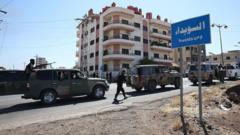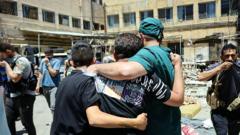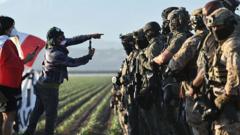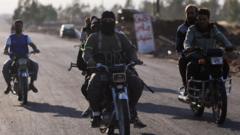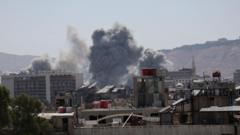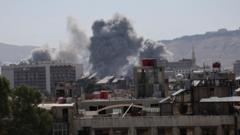As Homs begins to rebuild after years of war, residents like Baraa and her family find hope and optimism, despite the scars left by the conflict. Their stories highlight the resilience of the human spirit in a city marked by both pain and the promise of renewal.
Hope Amidst Ruins: Homs Reflects on its Resilient Spirit and Future
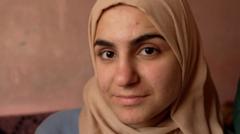
Hope Amidst Ruins: Homs Reflects on its Resilient Spirit and Future
In the city once deemed the 'capital of the revolution,' locals share a mix of joy and sorrow as they navigate life after years of conflict.
Article Text:
Baraa, now a 20-year-old university student, reflects on a past filled with grief and survival as she celebrates the end of Bashar al-Assad's rule with her family in Homs, Syria’s once-celebrated "capital of the revolution." Recounting her childhood memories from nearly a decade ago, she recalls the nightmare of war that tore through their lives and left indelible scars.
“Even now, I look back and wonder how we survived this nightmare,” Baraa shared in a quiet moment, her sisters Ala and Jana offering silent support as they gathered in their modest home amid the winter chill. Their father, Farhan Abdul Ghani, joined the conversation with a solemn reflection: "We did not want war. We did not want a forever president who builds monuments to himself."
During the peak of the conflict in Homs, Baraa was a frightened little girl who witnessed unimaginable suffering. “Sometimes people killed cats to eat,” she once expressed, her innocent voice tinged with shock. Food was scarce; families relied on grass and leaves to survive during the prolonged sieges enforced by government troops.
Homs had once been alive with the spirit of revolution when peaceful protests erupted in 2011, calling for change. Baraa and her family experienced horror when they were amongst the civilians rescued during a rare UN-sanctioned humanitarian pause in February 2014. They endured a brutal two-year siege where "surrender or starve" tactics were employed.
As Baraa emerged into a new chapter, she expressed hope for the future. "I am dreaming of so many things now, to finish university, to do a master's degree, to improve my English," she declared, reflecting the transformation from a traumatized child to a determined young woman.
Her father, whose joy is evident, navigated the difficulties of parenthood alone after their mother was tragically killed. The improving economy is a welcomed relief; he notes that "everything is cheaper now, including food and electricity,” encouraging the family to dream of a better life amidst the remnants of their past.
However, the bittersweet memories linger. Dr. Hayan al-Abrash, a fellow Homs resident who lost a brother in the notorious Saydnaya prison, grapples with his grief amid the rubble of his beloved city. "They feared doctors, lawyers, political figures even more than they feared the fighters," he remarks, expressing his continued anger at the regime's atrocities.
Yet amid the sorrow lies a shared resolve among Homs's residents, Muslims and Christians alike, to rebuild their community. “We don’t forgive. It's impossible for us,” Dr. al-Abrash insists, yet he emphasizes the importance of collective healing.
Together, the citizens of Homs, including local clergy such as Father Tony Homsy, are committed to rebuilding connections and memories, understanding that healing will take time. Ambitions of future unity symbolize their resistance against a painful past, reminding the world that within the ruins, the spirit of Homs persists, determined to rise again.
Baraa, now a 20-year-old university student, reflects on a past filled with grief and survival as she celebrates the end of Bashar al-Assad's rule with her family in Homs, Syria’s once-celebrated "capital of the revolution." Recounting her childhood memories from nearly a decade ago, she recalls the nightmare of war that tore through their lives and left indelible scars.
“Even now, I look back and wonder how we survived this nightmare,” Baraa shared in a quiet moment, her sisters Ala and Jana offering silent support as they gathered in their modest home amid the winter chill. Their father, Farhan Abdul Ghani, joined the conversation with a solemn reflection: "We did not want war. We did not want a forever president who builds monuments to himself."
During the peak of the conflict in Homs, Baraa was a frightened little girl who witnessed unimaginable suffering. “Sometimes people killed cats to eat,” she once expressed, her innocent voice tinged with shock. Food was scarce; families relied on grass and leaves to survive during the prolonged sieges enforced by government troops.
Homs had once been alive with the spirit of revolution when peaceful protests erupted in 2011, calling for change. Baraa and her family experienced horror when they were amongst the civilians rescued during a rare UN-sanctioned humanitarian pause in February 2014. They endured a brutal two-year siege where "surrender or starve" tactics were employed.
As Baraa emerged into a new chapter, she expressed hope for the future. "I am dreaming of so many things now, to finish university, to do a master's degree, to improve my English," she declared, reflecting the transformation from a traumatized child to a determined young woman.
Her father, whose joy is evident, navigated the difficulties of parenthood alone after their mother was tragically killed. The improving economy is a welcomed relief; he notes that "everything is cheaper now, including food and electricity,” encouraging the family to dream of a better life amidst the remnants of their past.
However, the bittersweet memories linger. Dr. Hayan al-Abrash, a fellow Homs resident who lost a brother in the notorious Saydnaya prison, grapples with his grief amid the rubble of his beloved city. "They feared doctors, lawyers, political figures even more than they feared the fighters," he remarks, expressing his continued anger at the regime's atrocities.
Yet amid the sorrow lies a shared resolve among Homs's residents, Muslims and Christians alike, to rebuild their community. “We don’t forgive. It's impossible for us,” Dr. al-Abrash insists, yet he emphasizes the importance of collective healing.
Together, the citizens of Homs, including local clergy such as Father Tony Homsy, are committed to rebuilding connections and memories, understanding that healing will take time. Ambitions of future unity symbolize their resistance against a painful past, reminding the world that within the ruins, the spirit of Homs persists, determined to rise again.

